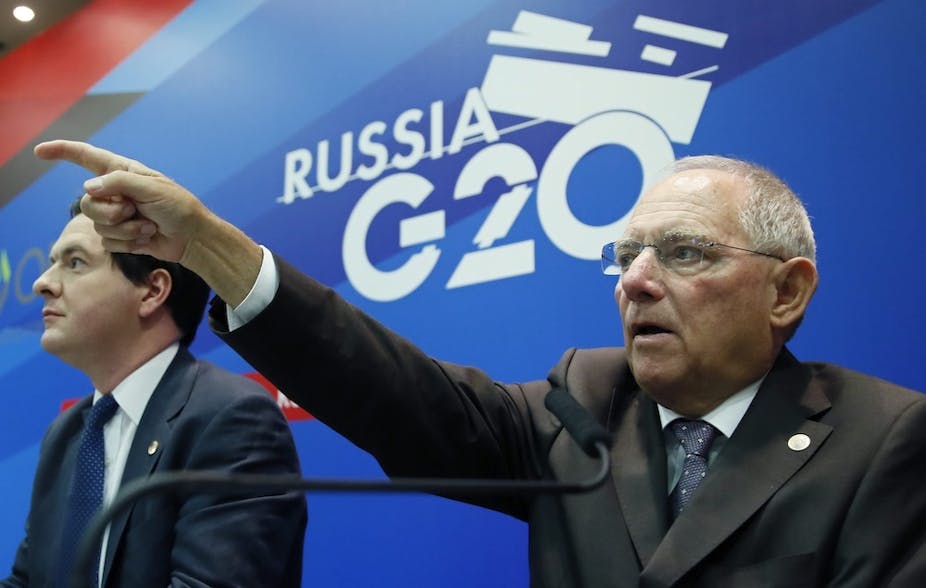A sherpa, a sous sherpa and a yak walk into a troika meeting. Alas, this is not the beginning of a shaggy dog joke, it is a normal description of a Group of 20 (G20) process. Arcane and obscure terminology are the order of the day for a G20 Summit, which is the natural consequence of letting an international forum be designed by finance officials.
But fear not, over the course of several posts, we will guide you through what the G20 is, what you need to know about it, what is being decided in St Petersburg in early September and why everyone in Brisbane should move to Noosa in late 2014 when the G20 Leaders Summit rolls into Brisbane next November.
But you do need to know. Australians need to pay attention to what has happened in the tangled world of international financial regulation since the G20 burst onto the scene in 2008. We are part of this leadership group, so we had better do our best, and be clear about what the Australian Government is committing us to.
The G20 describes itself as “the premier forum for international cooperation on the most important issues of the global economic and financial agenda”.
The G20 brings together leaders, finance ministers and central bank governors from 19 countries in a series of meetings. The countries are Argentina, Australia, Brazil, Canada, China, France, Germany, India, Indonesia, Italy, Japan, the Republic of Korea, Mexico, Russia, Saudi Arabia, South Africa, Turkey, the United Kingdom, the United States of America, plus the European Union, which is represented by the President of the European Council and by the Head of the European Central Bank.
The host gets five extra invitations, but Spain is always one of these as a “permanent guest”. Usually, the chair of ASEAN and the African Union get invited. The heads of the International Monetary Fund, the OECD and World Bank also come, and some UN chiefs.
So there are lots of questions already. You can see the G8 countries are all there. You can also see the rising economies are there, often called the “BRICS” - Brazil, Russia, India, China and South Africa. The G20 is not necessarily the 19 richest nations in any given year, on a GDP or on a per capita basis. The G8 were asked to invite counterparts from a number of “systemically important countries” from regions around the world to make a more representative body.
The G20 is outside the United Nations system. G20 declarations do not bind any other nation, or even each other except for peer pressure. No one voted these countries to be economic leaders, unlike the Security Council which has five permanent members (US, Russia, China, France and UK), and then an elaborate election system for the other ten seats.
Australia had to wage and win a long campaign in order to be elected for two years from 2013-2014 to deal with threats to international peace and security. The G20 is more like a discussion group, with a big, flexible agenda. Questions about its membership and legitimacy are ongoing.
So why does everyone care so much about the G20? Well, as DFAT puts it:
“G20 members account for 85% of the world economy, 80% of global trade, and two-thirds of the world’s population. The G20 represents all geographic regions of the world, but remains small enough to be an effective decision-making body.”
So when the world was facing a financial crisis, the G20 was seen as nimble enough to do some crisis management. More of that in future posts.
There is no secretariat either, unlike the UN. The G20 works on a troika system, where the previous host, the current host and the country about to host share organising duties. So Australia (2014 host) is part of the troika with Mexico (2012) and Russia (2013), and later this year, Turkey will join as the 2015 host.
There are lots and lots of meetings leading up to the Leaders Summit. Before the G20 summit in Brisbane from 15-16 November, there will be two big meetings of the finance ministers and treasurers, the first of which will be held in Sydney on February 22 and 23 and the second in Cairns on September 20 and 21. Not to mention all kinds of satellite meetings, which we will unpack for you over coming weeks.
The glue of the whole process is the sherpas, who lead the “sherpa track” negotiations. The sherpa is the personal representative of the leader, in our case, the Prime Minister, helping them to reach the summit (boom tish). The Australian sherpa since 2010 has been Dr Gordon de Brouwer PSM, Associate Secretary (Domestic Policy Group), Department of the Prime Minister and Cabinet of Australia. The sous sherpa and yak are senior public officials helping the sherpa or the Finance Minister. So the Leaders Meeting is crucial to fostering the political support necessary to coordinate and solve problems that cross state borders, like corporate tax evasion. But public officials are also crucial to the long-term development of the G20 as an institution, and problems that take a long time to fix.
So the G20 aims to promote:
- policy coordination between its members in order to achieve global economic stability, and sustainable balanced growth
- financial regulations that reduce risks and prevent future financial crises
- and modernise international financial architecture.
What could be more exciting? I know, pretty much everything. But maybe it could be a bank, not a terrorist that damages your kid’s future the most. So stay tuned…
Susan Harris Rimmer will be attending the G20 Leaders Summit in St Petersburg as a media correspondent for The Conversation.

